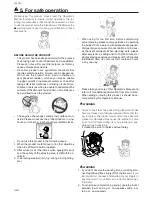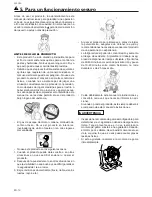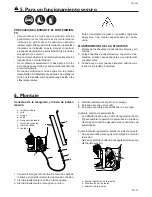
325S25
GB-9
WARNING
• Highly combustible. When refueling, switch the
engine off and keep well away from naked flames.
• After filling the tank with fuel, firmly tighten the cap.
a
b
■
Starting engine
WARNING
• Before starting the engine, make sure that the spray
lever (spray valve) is completely returned. Starting
with the spray lever still pulled out is dangerous, as
chemical fluid may spray out of the nozzle as soon as
the engine is started.
• To start the engine, place the sprayer on an even and
stable surface or platform. If the sprayer is unstable,
the reaction on starting etc. may cause it to fall.
IMPORTANT
• Do not allow the chemical fluid or water in the tank to
run out while the engine is running. If the engine runs
empty it may cause breakage of the spray pump.
• Make sure that the gear oil is filled until the middle of
9. Operation
the check-window. If it is not enough, loose the upper
bolt and fill the gear oil. (SAE40CC)
(1)
(2)
(3)
1. Press the primer at the bottom of the carburetor a few
times with your finger until the fuel starts to flow through
the transparent pipe.
NOTE
• There is no need to operate the primer when restarting
immediately after stopping the engine, provided there
is fuel left in the fuel tank.
2. Lift the choke lever on the right of the air cleaner until
it is in the “closed” position, then open the throttle
lever on the main unit side about 1/3-1/2 from the
“slow” position.
8. Chemical filling
WARNING
• Chemical substances should be handled correctly,
observing the precautions marked on the container.
Some chemicals are extremely hazardous to humans
and animals, and handling errors can cause serious
poisoning or even fatal accidents.
• When not in use, chemical substance containers
should be stored separately from other containers out
of the reach of children.
•
IMPORTANT
• Do not fill the chemical tank with undiluted fluid. This
could cause the gasket and valves to lose their du-
rability.
■
Procedure for filling
1. Use a bucket or other suitable container and dilute the
chemical to the requisite strength.
2. Place the sprayer on an even and stable surface and
remove the chemical tank cap.
3. Fill the tank by passing chemical through the strainer.
4. When filling is complete, firmly tighten the cap.
a. strainer
• Chemical tank capacity: 25 litres
a. cap
b. fuel tank
a. air cleaner
b. choke lever
c. close
d. open
e. transparent pipe
f. primer
g. throttle lever
h. fast
i. slow
(1) bolt
(2) window
(3) drain bolt










































